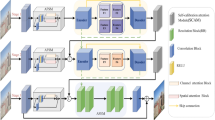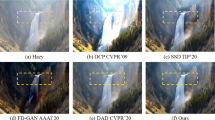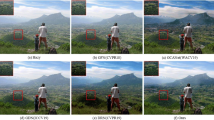Abstract
In the past few years, significant research on single-image dehazing has developed rapidly. Despite this effort, it is still hard to remove the dense haze completely, particularly in complex real-world cases. The real-world haze is non-uniform and varied (light or dense). In the non-uniform case, the structure of the image can be destroyed. Besides, the procedure of dense haze removal usually leads to color distortion, detail loss and structure blurring, which increases the difficulty of image restoration. To solve these problems, we propose a multi-group feature enhancement network (MGFEN) based on a global and local context fusion pattern to remove haze progressively. Unlike previous methods, we develop a global feature fusion (GFF) module which takes a more global perspective to extract features and performs attention fusion with high-frequency features obtained from the Laplace pyramid to effectively preserve structure information of the image and remove artifacts caused by non-uniform haze. We also design a feature residual enhancement (FRE) module to improve image details and boost color fidelity by enhancing effective residuals group by group. The Experimental results of different datasets show that our MGFEN establishes the new state-of-the-art performance for real-world non-uniform and dense haze removal both in objective metrics and visual quality with better structure and color recovery ability.











Similar content being viewed by others
Data availability
The datasets generated during and/or analysed during the current study are available from the corresponding author on reasonable request.
References
Ancuti CO, Ancuti C, Sbert M et al (2019) Dense-haze: a benchmark for image dehazing with dense-haze and haze-free images [C]//2019 IEEE international conference on image processing (ICIP). IEEE 1014–1018
Ancuti CO, Ancuti C, Timofte R et al (2018) O-haze: a dehazing benchmark with real hazy and haze-free outdoor images [C]// Proceedings of the IEEE conference on computer vision and pattern recognition workshops. 754–762
Berman D, Avidan S (2016) Non-local image dehazing [C]//Proceedings of the IEEE conference on computer vision and pattern recognition. 1674–1682
Berman D, Treibitz T, Avidan S (2018) Single image dehazing using haze-lines [J]. IEEE Trans Pattern Anal Mach Intell 42(3):720–734
Bu Q, Luo J, Ma K, Feng H, Feng J (2020) An enhanced pix2pix dehazing network with guided filter layer [J]. Appl Sci 10(17):5898
Chen Y, Li W, Sakaridis C et al (2018) Domain adaptive faster r-cnn for object detection in the wild [C]//Proceedings of the IEEE conference on computer vision and pattern recognition. 3339–3348
Chen Z, Wang Y, Yang Y et al (2021) PSD: Principled synthetic-to-real dehazing guided by physical priors [C]//Proceedings of the IEEE/CVF conference on computer vision and pattern recognition. 7180–7189
Dong H, Pan J, Xiang L et al (2020) Multi-scale boosted dehazing network with dense feature fusion [C]//Proceedings of the IEEE/CVF Conference on Computer Vision and Pattern Recognition. 2157–2167
Gao SH, Cheng MM, Zhao K et al (2019) Res2net: A new multi-scale backbone architecture [J]. IEEE Trans Pattern Anal Mach Intell 43(2):652–662 Y-net-26
Girshick R (2015) Fast r-cnn [C]// Proceedings of the IEEE international conference on computer vision. 1440–1448
Guo CL, Yan Q, Anwar S et al (2022) Image Dehazing Transformer with Transmission-Aware 3D Position Embedding [C]//Proceedings of the IEEE/CVF Conference on Computer Vision and Pattern Recognition. 5812–5820
Hassan H, Mishra P, Ahmad M, Bashir AK, Huang B, Luo B (2022) Effects of haze and dehazing on deep learning-based vision models [J]. Appl Intell 52:1–19
He K, Sun J, Tang X (2010) Single image haze removal using dark channel prior [J]. IEEE Trans Pattern Anal Mach Intell 33(12):2341–2353
Hong M, Xie Y, Li C et al (2020) Distilling image dehazing with heterogeneous task imitation [C]//Proceedings of the IEEE/CVF Conference on Computer Vision and Pattern Recognition. 3462–3471
Huang Y, Chen X (2021) Single remote sensing image dehazing using a dual-step cascaded residual dense network [C]//2021 IEEE international conference on image processing (ICIP). IEEE 3852–3856
Kan S, Zhang Y, Zhang F et al (2022) A GAN-based input-size flexibility model for single image dehazing [J]. Signal Process Image Commun 102:116599
Khan S, Naseer M, Hayat M, Zamir SW, Khan FS, Shah M (2022) Transformers in vision: a survey [J]. ACM Comput Surv (CSUR) 54(10s):1–41
Li B, Peng X, Wang Z et al (2017) Aod-net: All-in-one dehazing network [C]//Proceedings of the IEEE international conference on computer vision. 4770–4778
Li B, Ren W, Fu D, Tao D, Feng D, Zeng W, Wang Z (2018) Benchmarking single-image dehazing and beyond [J]. IEEE Trans Image Process 28(1):492–505
Lin TY, Dollár P, Girshick R et al (2017) Feature pyramid networks for object detection [C]// Proceedings of the IEEE conference on computer vision and pattern recognition. 2117–2125
Liu W, Anguelov D, Erhan D et al (2016) Ssd: single shot multibox detector [C]// European conference on computer vision. Springer, Cham, 21–37
Liu S, Huang D, Wang Y (2019) Learning spatial fusion for single-shot object detection [J]. arXiv preprint arXiv:1911.09516
Liu X, Ma Y, Shi Z et al (2019) Griddehazenet: Attention-based multi-scale network for image dehazing [C]// Proceedings of the IEEE/CVF international conference on computer vision. 7314–7323
Liu S, Qi L, Qin H et al (2018) Path aggregation network for instance segmentation [C]// Proceedings of the IEEE conference on computer vision and pattern recognition. 8759–8768
Liu H, Wu Z, Li L et al (2022) Towards Multi-Domain Single Image Dehazing via Test-Time Training [C]//Proceedings of the IEEE/CVF Conference on Computer Vision and Pattern Recognition. 5831–5840
Middleton WEK (1952) Vision through the atmosphere [M]. University of Toronto Press
Qin X, Wang Z, Bai Y et al (2020) FFA-Net: Feature fusion attention network for single image dehazing [C]// Proceedings of the AAAI Conference on Artificial Intelligence. 34(07):11908–11915
Ren W, Ma L, Zhang J et al (2018) Gated fusion network for single image dehazing [C]//Proceedings of the IEEE Conference on Computer Vision and Pattern Recognition. 3253–3261
Sakaridis C, Dai D, Hecker S et al (2018) Model adaptation with synthetic and real data for semantic dense foggy scene understanding [C]//Proceedings of the European Conference on Computer Vision (ECCV). 687–704
Sakaridis C, Dai D, Van Gool L (2018) Semantic foggy scene understanding with synthetic data [J]. Int J Comput Vis 126(9):973–992
Shao Y, Li L, Ren W et al (2020) Domain adaptation for image dehazing [C]// Proceedings of the IEEE/CVF conference on computer vision and pattern recognition. 2808–2817
Shao X, Wei C, Shen Y, Wang Z (2020) Feature enhancement based on CycleGAN for nighttime vehicle detection [J]. IEEE Access 9:849–859
Sharma T, Agrawal I, Verma NK (2020) CSIDNet: compact single image dehazing network for outdoor scene enhancement [J]. Multimed Tools Appl 79(41):30769–30784
Song Y, He Z, Qian H et al (2022) Vision Transformers for Single Image Dehazing [J]. arXiv preprint arXiv:2204.03883
Wang C, Fan W, Wu Y, Su Z (2020) Weakly supervised single image dehazing [J]. J Vis Commun Image Represent 72:102897
Wang T, Zhao L, Huang P, Zhang X, Xu J (2021) Haze concentration adaptive network for image dehazing [J]. Neurocomputing 439:75–85
Wu H, Qu Y, Lin S et al (2021) Contrastive learning for compact single image dehazing [C]// Proceedings of the IEEE/CVF Conference on Computer Vision and Pattern Recognition. 10551–10560
Yang Y, Wang C, Liu R et al (2022) Self-Augmented Unpaired Image Dehazing via Density and Depth Decomposition [C]//Proceedings of the IEEE/CVF Conference on Computer Vision and Pattern Recognition. 2037–2046
Yang HH, Yang CHH, Tsai YCJ (2020) Y-net: multi-scale feature aggregation network with wavelet structure similarity loss function for single image dehazing [C]// ICASSP 2020-2020 IEEE international conference on acoustics, speech and signal processing (ICASSP). IEEE 2628–2632
Yu Y, Liu H, Fu M et al (2021) A two-branch neural network for non-homogeneous dehazing via ensemble learning [C]//Proceedings of the IEEE/CVF conference on computer vision and pattern recognition. 193–202
Zamir SW, Arora A, Khan S et al (2022) Restormer: Efficient transformer for high-resolution image restoration [C]// Proceedings of the IEEE/CVF Conference on Computer Vision and Pattern Recognition. 5728–5739
Zhang H, Cisse M, Dauphin YN et al (2018) mixup: Beyond Empirical Risk Minimization [C]// International Conference on Learning Representations
Zhang X, Dong H, Pan J et al (2021) Learning to restore hazy video: A new real-world dataset and a new method [C]// Proceedings of the IEEE/CVF Conference on Computer Vision and Pattern Recognition. 9239–9248
Zhao W, Zhao Y, Feng L, Tang J (2022) Attention optimized deep generative adversarial network for removing uneven dense haze [J]. Symmetry 14(1):1
Zotti C, Luo Z, Humbert O et al (2017) GridNet with automatic shape prior registration for automatic MRI cardiac segmentation [C]//international workshop on statistical atlases and computational models of the heart. Springer, Cham, 73–81
Funding
This study was supported by the Joint Fund of Ministry of Education for Equipment Pre-research (Grant number 8091B0203) and National Science and Technology Innovation 2030 Major Program (Grant number 2022ZD0205000).
Author information
Authors and Affiliations
Contributions
Conceptualization: Xiaotao Shao; Methodology: Xiaotao Shao; Formal analysis and investigation: Yan Guo; Writing - original draft preparation: Yan Guo; Writing - review and editing: Yan Shen; Funding acquisition: Yan Shen; Resources: Manyi Qian; Supervision: Manyi Qian; Validation: Zhongli Wang; Visualization: Zhongli Wang.
Corresponding author
Ethics declarations
Competing interests
The authors have no competing interests to declare that are relevant to the content of this article.
Additional information
Publisher’s note
Springer Nature remains neutral with regard to jurisdictional claims in published maps and institutional affiliations.
Rights and permissions
Springer Nature or its licensor (e.g. a society or other partner) holds exclusive rights to this article under a publishing agreement with the author(s) or other rightsholder(s); author self-archiving of the accepted manuscript version of this article is solely governed by the terms of such publishing agreement and applicable law.
About this article
Cite this article
Shao, X., Guo, Y., Shen, Y. et al. From local to global: a multi-group feature enhancement network for non-uniform and dense haze removal. Multimed Tools Appl 82, 27057–27073 (2023). https://doi.org/10.1007/s11042-023-14950-9
Received:
Revised:
Accepted:
Published:
Issue Date:
DOI: https://doi.org/10.1007/s11042-023-14950-9




